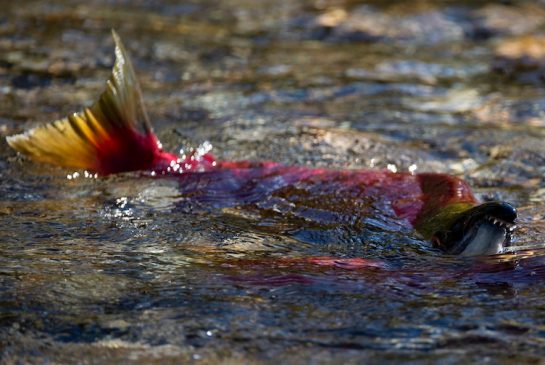
Whirling disease in the Bow River
As most anglers in southern Alberta are aware, this past season of fishing came with some very scary and dreaded news.
Whirling Disease has been discovered in our treasured and world renowned Bow River.
This was accompanied by a general feeling of dread and fear, as past case studies (Montana being the most commonly noted) have shown how destructive this particular parasite can be. While this is scary, we feel as though the most logical approach to solving, or at least mitigating the ill effects on our fisheries is through education; learning about the disease, and knowing what we can do as anglers to be part of the solution. And then ensuring our provincial government is doing what needs to be done to deal with this effectively.
For those of you that are not familiar with this parasite, below is a short overview of whirling disease in Alberta, written by a friend of the Bushwhackers Society, Joseph Morgan Casat. He wrote this piece for his class in the Fisheries and Wildlife program at Selkirk college and also appeared in the castlegar paper for his work. Enjoy!
Whirling down the Bow River
Joseph Morgan Casat
What a surprise, yet another invasive species we have to deal with. This time however, the invader is tiny, microscopic. This invasive species has made its way to the Bow River system in Banff National Park. A first appearance in Canada, the microscopic organism causes Whirling disease, affecting fish in the salmon family like Rainbow trout, everyone’s favorite game fish.
This disease causes a deformed spine and blackened tail, making it look as if someone has pinched and bent the spine near the tail. It also reshapes the head, making it squarer.
Whirling disease showed up in North America first in Pennsylvania in 1956. Because this disease is endemic to Europe, the fish there have gained a sort of immunity to the parasites. In North America, our fish have little immunity to the disease. Currently fish populations are being closely monitored around the Great Lakes since it was detected in some American hatcheries, but still was never recorded in Canada…until now.
While there is no risk to human health when consuming infected fish, it can be lethal to the fish it infects. The parasites first infect sludge worms, a common worm found in the sediment of most lakes and rivers. At some point, infected worms are then consumed by juvenile fish and causes skeletal deformation and neurological damage. Both of these lead an awkward corkscrew swimming pattern, usually belly up, giving the disease its name. Due to the effects of this disease, it becomes difficult for fish to feed and they are more prone to predation. Once the fish dies, the parasite returns to the water, are consumed by the aquatic worms and the cycle continues. The parasites end up in new places by the movement of infected fish, infected worms, contaminated equipment, birds or water
On August 23, 2016 The Canadian Food Inspection Agency confirmed Whirling disease to be present in fish found in Jonson Lake in Banff. In an attempt to control spreading, the lake was closed soon thereafter. The concern was that it would flow out of the lake and into the connecting river systems. Jonson Lake flows into Cascade River which then connects to Bow River.
On September 7th, a fish taken from just below the confluence of the Cascade and Bow Rivers tested positive for Whirling disease. Recently there have been more cases including several in unnamed commercial aquaculture facilities in Alberta. It’s also been found in a section of the Lower Bow river to Tunnel mountain, Carrot Creek, all of the Cascade River as well as Cascade creek, and Spray river upstream of the confluence the Bow and Cascade rivers. It’s spreading quickly.
There is no known cure for the disease but that doesn’t mean we are helpless. Anglers and recreational river users can take steps to prevent the spread of the parasite. Clean, Drain, Dry is a slogan used in attempt to stop the spread of other invasive species via boats. It also applies for the spread of Whirling disease. The program is intended to encourage boaters to clean, drain and dry their boats before transporting them between different water sheds.
Dispose of fish entrails and carcasses when done fishing. Clean your footwear, waders, lines and flies in a bleach and water solution when moving to a new area, stream or water body. Check online for reports of the disease in waters you intend to fish. By learning to recognize the symptoms of the disease and not transporting infected fish whether dead or alive, you can also reduce the chance of the disease spreading.
For more information and updates on Whirling disease in the Bow River, I recommend heading over to Alberta Fishing Guide Magazine. Dave Jensen is a prominent fly-fishing figure in Alberta and is certainly in the know when it comes to these sort of things. Below is a link!
http://afgmag.com/whirling-disease-update-information/